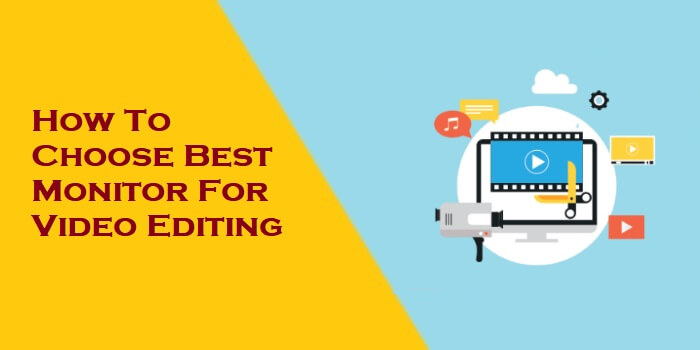Choosing a monitor for video editing can be difficult; however, there are numerous things to consider before buying one. It is anything but difficult to buy the supplier or what is regarded as the best by the benchmark; nonetheless, there are several other things not to ignore before buying one.
It would be best if you had a high-caliber monitor so your changes will be visible after the job is done. Shading precision is crucial to video editing because it makes it easier for a video editor to address mistakes and makes it easier for your viewers to appreciate the content you produce.
So it is ideal if your screen provides precise shading clarity and a full color range. This will enable you to customize your settings across several different kinds of work that require substantial shading, for example, photorealistic planning as an originator or video altering as an editor.
Keeping in mind that there are a lot of screens with shading on the market, you need to ensure that you receive the greatest value for the money given. Furthermore, you ought to consider a decent editorial manager in your life as a video producer.
Intending to make your video altering task more straightforward, we have assembled a rundown of screens that meet these prerequisites so it can run as smoothly as possible for you. Click here to check the article of Best Monitor For Video Editing.
How To Choose Best Monitor For Video Editing
Screen Size:
For more involved seeing during those day-long (or overnight!) meetings, select a screen that measures at least 19″, 21.5″, 24, 27, and 32″. Most noteworthy, 40″+ screens are an option if you have the space to accommodate their reasonable view separations.
Screen Resolution:
When editing in 4K, if you can afford the higher resolution screen, choose that. However, using intermediaries will work entirely for you if you alter your 4K film using an editing system that is not 4K-ready.
If you were looking to buy the best monitors according to your budget tag, please check out our articles on this topic:-
On the off chance that you desire to change your screen to 4K first, you can do so, regardless of whether it will be in a smaller, “windowed” arrangement. If you’re substantially analyzing hues, 4K+ is the ideal goal.
HDR Support:
HDR technology changes the shading force and contrast of your pictures to a magnificent degree. The screen’s brightness varies in cd/m2 (candles/meter squared or nits); 1000 cd/m2 or above is ideal for HDR adjusting. The most common HDR standard is HDR10, with Dolby Vision or HDR10+ accessible on specific screens, so look for the standard supported by your altering framework.
Shading Support:
Support for shading extents is measured by the rate the screen covers. Rec.2020, Adobe RGB, and DCI-P3, for example, have greater shading points of interest, especially when comparing them with more established standards such as sRGB/Rec709.
The greater the shading profundities, the greater the detail available to control, with the exception of the 10-piece screen, which must be handled by the GPU, operating system, and so on. If you’re a YouTuber, vlogger, or television advertiser who takes shots, edits them and then uploads them to a status, then you may hope to stick with more budget-friendly 8-piece shading screens.
Matte and Glossy Monitors:
Optical panels with a high gloss finish show more images and are a good choice for clients who do not change recordings often. Unlike what one would expect, Matte boards display more accurate colors and shapes closer to reality. They do not reflect light from the surface, making them progressively valuable for use.
Network:
There are a variety of screen inputs such as HDMI, 12G/6G/3G-SDI (BNC), DisplayPort, USB, and optical varieties; ensure your presentation is perfect with your system’s video output. You can connect your sign to a bigger screen for future use if you have a circle out port. Select screens offer sound I/O options that allow you to assign an implanted sound to outside speakers.
Alignment:
These screens have alignment programming or can be balanced with an adjustment LUT. These are essential for maintaining a consistent look in your venture. A few screens accompany alignment programs or can be balanced with an adjustment LUT. If you can afford it, it would be wise to invest in an alignment program with a fixed test as it can be used correctly with different screen models. Alternatively, you can pay an expert for the first adjustment and become accustomed to the process yourself.
Backdrop illumination Uniformity:
The most ideal video-altering screens have consistently consistent backlighting. The best brands are EIZO and NEC. Both brands show similar luminance levels and shading temperatures across the entire screen, with a few exceptions, however. For those individuals who want to acquire a 27-inches screen or something bigger, it will be hard to achieve consistency without losing a great deal of cash. High-background illumination screens are costly when in doubt, so it is essential to opt for another range.
Screen Contrast:
Essentially, this boundary refers to the contrast between the best and the darkest picture on your screen. That is why it is enthusiastically recommended that you buy a screen that has a higher contrast ratio to more clearly differentiate between light and dark scenes.
Revive Rate:
The refresh rate is measured in Hertz, which is proportionate to the number of cases a screen can show per second. A high refresh rate is not significant for video editing since a standard screen refresh starts at 60 hertz and above. Whenever you edit video and mess around with your computer screen, you will require a higher invigorate rate. The higher interactivity quality will give you a smoother experience.
